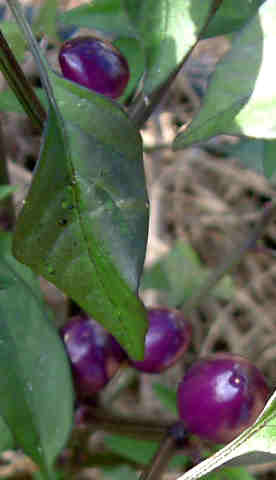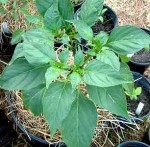Pretty Purple Pepper in the Garden
Pretty Purple Pepper is not only a variety name, but an accurate description of the plant and its fruit! Let’s talk a little about growing this wonderful pepper variety in the garden.
How Does it Look?
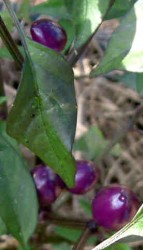 It’s really hard to capture with a photo how lovely both the plant and the peppers are! The stems are a deep purple-maroon color, and the leaves have a violet sheen to them (which I can’t seem to capture). And the peppers — they are a gorgeous, glowing purple.
It’s really hard to capture with a photo how lovely both the plant and the peppers are! The stems are a deep purple-maroon color, and the leaves have a violet sheen to them (which I can’t seem to capture). And the peppers — they are a gorgeous, glowing purple.
This pepper has been quite hardy in my garden. It’s faced a near-freeze with grace, and is thriving in a 3-gallon container. I drop by it at least once a day because it’s a feast for my eyes.
(You can click on the photo for a larger image.)
Germinating the Seeds
I find that germinating seeds for this pepper to be easy. Even in a cooler temperature than normal, the plant came up within 10 days. I imagine that if I used a heat mat, that would shorten to 5-7 days.
I germinated this particular plant at cooler-than-normal temperatures as an experiment. Pretty Purple Pepper sprouted well, but the other seeds had a hard time, and most didn’t germinate at all.
(Here’s more information about germinating hot pepper seeds, if you need a few tips.)
Container Growing
I mentioned that I am currently growing this plant in a 3-gallon container, and it is thriving. While it would do better in the ground, it’s quite suitable for a lovely container plant on a patio. Not only is the plant pleasing to look at but it also has purple-and-white flowers. When the plant has flowers and peppers at the same time, it’s a sight to behold!
Other Hints for Pretty Purple Pepper
As I mentioned, this plant has had some tough conditions. Not only has it faced temperatures in the 30’s, but it’s also faced extended periods of high winds. The weather has been dry, and sometimes the soil isn’t as damp as I’m sure the plant would like. Through all this, Pretty Purple Pepper has sailed on without a problem.
What About Eating Them?
You can certainly eat these peppers, but they are quite hot — my guess is around 40,000 Scoville Units. I don’t eat a lot of them, because they are so lovely on the plant. But I reccomend them  in stir-fries and also for a vinegar pepper. And although I haven’t tried them as such, I imagine they would be good pickled.
I like Pretty Purple Pepper, and it has an ongoing spot in my garden. I hope you like it too!
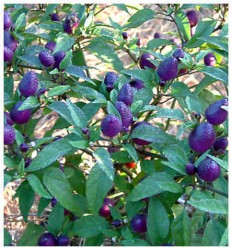
Update
Here’s another photo just a couple weeks later of the same plant!
Growing Banana Peppers
Growing banana peppers is really easy, as they are one of the most forgiving varieties. Still, they do need some care. Let’s take a look at growing banana peppers in the garden.
Type of Banana Peppers
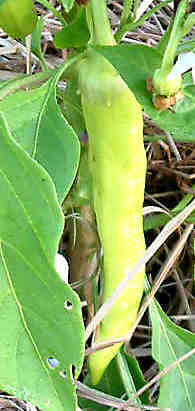 These versatile veggies go by several names, but they can be divided into two main types:Â sweet banana peppers and hot banana peppers.
These versatile veggies go by several names, but they can be divided into two main types:Â sweet banana peppers and hot banana peppers.
The most common banana pepper is called Hungarian, and it’s also available both ways. So that’s something to keep in mind when you are perusing the seeds!
The hot variety of the banana pepper reaches around 3,500 to 4,000 Scoville Units — about on par with jalapenos.
Growing Banana Peppers in Containers
Sure, you can grow these peppers in containers. For a bountiful harvest, I suggest 5-gallon containers. However, with a good potting soil, plenty of fertilizer, water and sunshine, they can also be grown successfully in 3-gallon pots.
Here’s more detailed information about container pepper growing.
Peppers in the Garden
Peppers, including the bananas, have similar requirements to their relative the tomato. That includes a fertilizer that has more phosphorus (the middle number of the fertilizer content) than nitrogen. While a lot of nitrogen will grow you large, lush plants, you won’t get many peppers off it.
Peppers like rich, well-drained soil. I’ve found that they also appreciate “fluffy” soil, which doesn’t compact easily, but which holds enough water to keep the plant happy. I do this by incorporating compost, sphagnum moss and perlite in the planting hole and surrounding soil.
Peppers like warm weather, especially the hot varieties. They don’t appreciate a windy location, so if you do get really breezy on a regular basis, see about constructing a wind break of sorts.
What About Eating?
You can eat the banana peppers when they are immature (green), ripe (red) or anywhere in between!
Here’s a hint: a sweet pepper will grow sweeter the riper it gets. Similarly, a hot banana pepper will turn up the heat, the riper it is.
Enjoy growing (and eating) your banana peppers!
Jalapenos in the Garden
Jalapenos have to be the most-recognized chile pepper around. You probably see them at the grocery store, and you’ve likely downed your share of them. But what about growing them in the garden?
The Humble Jalapeno
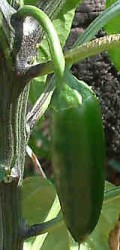 You may not know this, but there are a multitude of jalapeno varieties. They all have the same basic pepper shape, but would you believe they come in different colors? Not to mention different sizes and Scoville units (“heat” to the uninitiated).
You may not know this, but there are a multitude of jalapeno varieties. They all have the same basic pepper shape, but would you believe they come in different colors? Not to mention different sizes and Scoville units (“heat” to the uninitiated).
Now most of the time the jalapenos you see and/or grow are the green peppers we all know and love. But they come in yellow and purple, too! And all varieties ripen to red (which can be fire-engine or quite deep burgundy).
How Hot — Or Not?
Yes it’s true, these versatile chile peppers come in several degrees of heat. There is the “regular” jalapeno, which is around 4,700 Scoville Units.
There’s also a “lite” variety called Tam Jalapeno that has less heat — somewhere in the vicinity of 2,000 SUs.
And for those who love these peppers but for whatever reason can’t take the heat — there is at least one variety that’s barely at 500 SUs.
To the best of my knowledge, there isn’t a super-hot jalapeno, but if you live in a warm climate, your peppers will get hotter as your weather warms up. In addition, if you let the peppers ripen to red, they are hotter yet!
Jalapenos — Does Size Matter?
You can look at this two ways — size of the pepper itself, or size of the plant.
There’s a variety called Mucho Nacho whose peppers are roughly twice the size of the standard jalapeno — great for anyone who can’t get enough of a good thing!
As far as the plants go — well, be prepared for the possibility of a large plant. Like 4 feet tall and just about as wide (yes, I’ve had them like that). That’s when they are planted in rich, well-drained soil and have plenty of warmth and at least 8 hours a day of direct sunlight.
If your soil, warmth or sunshine isn’t up to snuff, the plants will very likely be smaller; how much smaller depends on the conditions.  But 2 feet tall is a good guesstimate.
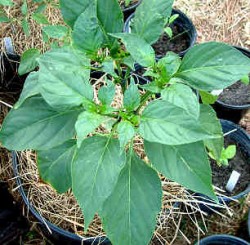 You can also grow these chile peppers in containers (which is what I am personally doing now). A 5-gallon pot will give you plenty of peppers to pick.
You can also grow these chile peppers in containers (which is what I am personally doing now). A 5-gallon pot will give you plenty of peppers to pick.
Just make sure to keep it well-watered and fertilize it more often than you would if it were in the ground. (I like to fertilize weekly, with 1/3 to 1/2 strength liquid fertilizer — fish emulsion is my favorite.)
The plant in the picture is roughly 18 inches tall at the moment, and it’s come through some chilly weather the last month or so. But now that the weather is warming up, I expect it to grow at least another 12 inches by the time everything is said and done. For more information, check out my post on growing chile peppers in containers.
No peppers are ready for picking, but I’ve got plenty of blooms to tantalize me, knowing that most (if not all) will become a hot jalapeno.
While I don’t know for certain, I’m pretty sure this is the variety called Jalapeno M. It’s a nice open-pollinated variety that does well in most climates. If you need some tips, check out the growing chile peppers post.
Jalapeno peppers in the garden are easy to grow and quite forgiving. Give your plant(s) some care and you may end up with more peppers than you know what to do with!
